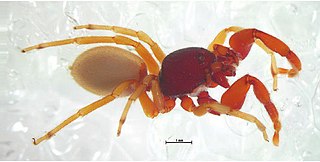
The Palpimanoidea or palpimanoids, also known as assassin spiders, are a group of araneomorph spiders, originally treated as a superfamily. As with many such groups, its circumscription has varied. As of September 2018, the following five families were included:

The anatomy of spiders includes many characteristics shared with other arachnids. These characteristics include bodies divided into two tagmata, eight jointed legs, no wings or antennae, the presence of chelicerae and pedipalps, simple eyes, and an exoskeleton, which is periodically shed.

Phidippus californicus is a species of jumping spider. It is found in the southwestern United States and northern Mexico.

Zygoballus sexpunctatus is a species of jumping spider which occurs in the southeastern United States where it can be found in a variety of grassy habitats. Adult spiders measure between 3 and 4.5 mm in length. The cephalothorax and abdomen are bronze to black in color, with reddish brown or yellowish legs. The male has distinctive enlarged chelicerae and front femora. Like many jumping spiders, Z. sexpunctatus males exhibit ritualized courtship and agonistic behavior.

Rugathodes sexpunctatus is a minute species of spider in the family Theridiidae, the cobweb or tangle-web spiders. This family includes the medically important genus Latrodectus—the widow spiders. The species in the genus Rugathodes are too small to be dangerous to humans. Very little is known about most species in this genus.
This glossary describes the terms used in formal descriptions of spiders; where applicable these terms are used in describing other arachnids.

Araneus mitificus, commonly known as the kidney garden spider or pale orb weaver is a species of orb-weaver spider found in South, East, and Southeast Asia.

Aptostichus barackobamai is a large species of trapdoor spider in the family Euctenizidae named after the 44th President of the United States, Barack Obama. The species was first reported by Jason Bond of Auburn University in December 2012 as one of 33 new species of the genus Aptostichus. The species is endemic throughout northern California, forming burrows out of silk, dirt, and sand, from which it attacks prey. This spider is identified by its dark red to red-brown coloration with a stripped or chevron patterned abdomen. Breeding occurs during the winter and females tend to be larger than their male counterparts. A. barackobamai is part of the larger Aptostichus icenoglei species complex, and is a close relative to Aptostichus icenoglei and Aptostichus isabella.
Chaco tucumana is a species of mygalomorph spiders of Argentina, named after its type locality: Tucumán. This species differs from C. obscura in the shorter male embolus and the shorter female spermathecal ducts. From other species of the genus it differs in its dark uniform color, the flexible anterior female tarsi, the denser scopulae on the posterior tarsi, and the female spermathecae without a basal protuberance. As in C. obscura, smaller specimens are much lighter in color, and it has darker spots that are evident on the sides of its cephalic region, the apex of femora, base of the patellae and lateral tibiae and dorsal abdomen. Larger specimens are much darker, almost black, with no visible pattern.
Ummidia algarve is a spider species found in Portugal. Unlike other known Ummidia species, it creates a trapdoor at the entrance of the burrow.

Zephyrarchaea is a genus of Australian assassin spiders first described by Michael Gordon Rix & Mark Harvey in 2012 for nine new species and two that were formerly placed in the genus Austrarchaea. The name is based on the Latin zephyrus, meaning "west wind", referring to the western distribution in Australia and a preference for windy, coastal habitats by some species. It has been encountered in Western Australia, Victoria and South Australia.
Pignus pongola is a species of jumping spider in the genus Pignus that lives in South Africa. The species was first described in 2009 by Wanda Wesołowska and Charles Haddad. It thrives in Mediterranean forests, woodlands, and scrub, including forest near rivers and coasts like fynbos. The spider is medium-sized, with a carapace that measures typically 3.6 mm (0.14 in) long and an abdomen 3.4 mm (0.13 in) long. It has a pattern similar to members of the Philaeus genus, to which Pignus is related. The most mouthparts are distinctive. While the chelicerae are similar in some respects to other species in the genus, they have a unique shape, being particularly large with a single long fang. The male's copulatory organs are also unusual. The palpal bulb has an unusually shaped tegulum, out of which extends a long thin embolus that curves up the bulb to its end. The female has not been described.

Paradonea presleyi is a species of araneomorph spiders in the family Eresidae.
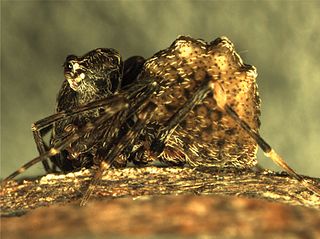
Zephyrarchaea mainae is a species of spider, informally known as Main's assassin spider, Albany assassin spider, and the Western archaeid spider. The first of the assassin spider family found in Western Australia, the species was unknown until its collection at Torndirrup National Park near Albany was published in 1987.
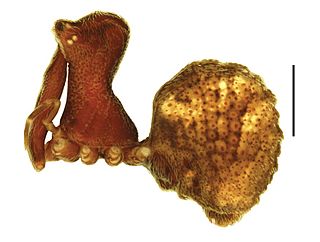
Zephyrarchaea grayi, also known as the Grampians Assassin Spider, is a species of spider in the family Archaeidae. It is endemic to Grampians National Park in Australia.
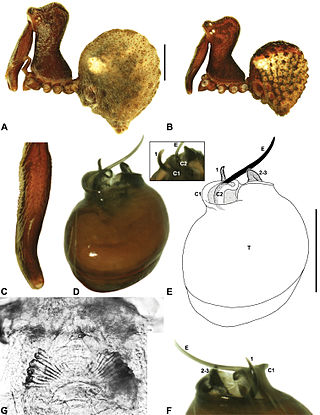
Zephyrarchaea marae, the West Gippsland assassin spider, is a spider in the family Archaeidae. The species was first described by Michael G. Rix and Mark Harvey in 2012. It is endemic to Victoria in Australia.
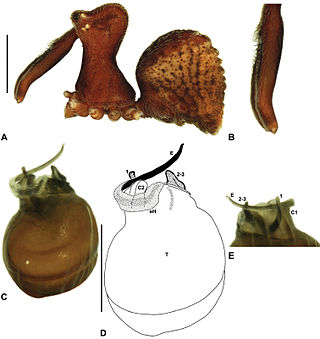
The Otway Range Assassin Spider(Zephyrarchaea porchi) is a species of spider in the family Archaeidae. It is endemic to Victoria, Australia.

Zephyrarchaea austini or the Kangaroo Island assassin spider is a species of Australian assassin spiders that is endemic to the north west of Kangaroo Island, South Australia. It was discovered in 2010, and described 2012 by Michael G. Rix and Mark Harvey, and named for Andy Austin.

Stenaelurillus albus is a species of jumping spider in the genus Stenaelurillus that lives in India. It was first described in 2015 by Pothalil A. Sebastian, Pradeep M. Sankaran, Jobi J. Malamel and Mathew M. Joseph. The spider was first found in Kerala but has also been observed in Karnataka, including the Mookambika Wildlife Sanctuary and Parambikulam Tiger Reserve. It prefers to live in the leaf litter found in deciduous forests. It is medium-sized, with a body length that ranges from 4.61 to 6.82 mm. The female is larger than the male. The female has a black oval cephalothorax which has a pattern of yellow bands and an oval abdomen that has yellow patches, the most pronounced three of which make a triangle shape, on a black background. The male differs in having a shiny black abdomen which has no patterns and a cephalothorax that is black with thick white stripes that mark the spider from front to back. This pattern distinguishes the species from others in the genus, including Stenaelurillus belihuloya. The sexual organs are also distinctive. The male has a brown palpal bulb that has two creamy-white markings on the rear and has a short, blunt embolus. These areas give the spider its name, from the Latin for white. The female has wide copulatory openings and small C-shaped spermathecae, and it is the latter that enables it to be distinguished from Stenaelurillus abramovi.
Rhondes flexibilis is an endemic species of jumping spider in the genus Rhondes that lives in New Caledonia. First described in 2016 by Barbara Patoleta, the species is common across the island, living in rainforests. It is small and slender, with a wide brown hairy cephalothorax and thinner abdomen that has a pattern of light and dark patches. The male, which is slightly larger, has a variably-shaped sclerite on the palpal bulb, after which the species is named. The female has a slightly less distinctive abdominal pattern and an epigyne with a relatively long and narrow pocket.
















